| Srl | Item |
| 1 |
ID:
085825


|
|
|
|
|
| Publication |
2008.
|
| Summary/Abstract |
In march 2008, parliament voted to extent Canadian military operations in Afghanistan through 2011. By July of that year, roughly 41000 Canadians will have served in the Afghan theatre of operations, 15000 more than fought in Korea.
|
|
|
|
|
|
|
|
|
|
|
|
|
|
|
|
| 2 |
ID:
105571


|
|
|
| 3 |
ID:
087897


|
|
|
| 4 |
ID:
081058
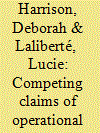

|
|
|
|
|
| Publication |
2008.
|
| Summary/Abstract |
This article explores the tension between military objectives and the "democracy value" cherished by Western civilian societies, using the situations of injured military members and the living conditions of civilian spouses; in particular, the responses of the Canadian Forces to members' posttraumatic stress disorder, and to spouses who are victims of domestic violence. The authors show how these responses currently privilege military objectives over the democracy value to an extent that is incompatible with the human rights of civilians or military members. They conclude by discussing how military leadership training could be modified to produce an altered balance between the two value systems
|
|
|
|
|
|
|
|
|
|
|
|
|
|
|
|
| 5 |
ID:
138757


|
|
|
|
|
| Summary/Abstract |
One of the most prominent debates over minority participation in the military has been whether or not inclusive policies would undermine operational effectiveness. While the adoption of inclusive policy has tended to indicate that minority participation does not compromise effectiveness, the question has not yet been tested in the context of transgender military service. In this paper, we conduct the first-ever assessment of whether policies that allow transgender troops to serve openly have undermined effectiveness, and we ask this question in the context of the Canadian Forces (CF), which lifted its transgender ban in 1992 and then adopted more explicitly inclusive policy in 2010 and 2012. Although transgender military service in Canada poses a particularly hard test for the proposition that minority inclusion does not undermine organizational performance, our finding is that despite ongoing prejudice and incomplete policy formulation and implementation, allowing transgender personnel to serve openly has not harmed the CF’s effectiveness.
|
|
|
|
|
|
|
|
|
|
|
|
|
|
|
|
| 6 |
ID:
106443
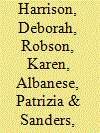

|
|
|
|
|
| Publication |
2011.
|
| Summary/Abstract |
Preliminary results of our survey of 1066 adolescent members of a Canadian Forces (CF) community, comparing the mental health and well-being of CF and civilian youth in a secondary school adjacent to an army base, yielded surprising results. The data were collected in 2008 with an instrument that replicated parts of the National Longitudinal Survey of Children and Youth (NLSCY). Our findings suggested that there are few statistically significant differences between CF and civilian youth on mental health and well-being measures. On the other hand, both the CF and civilian youth scored lower on crucial health and well-being measures than their peers in the national NLSCY sample. This research note attempts to explain these complementary findings, using data from follow-up semi-structured interviews we conducted in 2009/10 with 60 of the CF adolescents. It also considers the possibility of a ''spillover effect'' of military life stressors on civilian youth.
|
|
|
|
|
|
|
|
|
|
|
|
|
|
|
|
| 7 |
ID:
139207
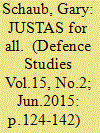

|
|
|
|
|
| Summary/Abstract |
Canada owns and uses unmanned aerial vehicles (UAVs), but its military services have acquired and integrated them into their force structure and operations with different degrees of ease. Service differences are explained with a three variable innovation adoption framework that integrates cost, impetus, and disruptive nature. The Army and Navy framed UAVs as relatively inexpensive adaptive innovation that would help avoid operational failures. The Air Force framed UAVs as expensive disruptive innovation that could improve performance of core functions but experienced UAVs as inexpensive adaptive innovations that helped avoid operational failure; yet these successes were perceived as inadequate. Analyzing services captures processes that national studies miss.
|
|
|
|
|
|
|
|
|
|
|
|
|
|
|
|
| 8 |
ID:
113112
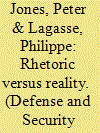

|
|
|
|
|
| Publication |
2012.
|
| Summary/Abstract |
As Canada's military mission in Afghanistan winds down and the country faces several years of fiscal austerity, all of Canada's major political parties are agreed that Canadian defence budgets must stay level or be cut. This comes at a time when the defence department is slated to replace the Canadian Forces' (CF) major equipment fleets. Canada's defence establishment thus faces some critical decisions. One option is to try to maintain its expeditionary capabilities across all three services: army, navy and air force. Absent substantial new infusions of funds, however, this approach is likely to lead to an overall and largely chaotic reduction of capabilities. Another option is to make some difficult choices as to which expeditionary capabilities to maintain as part of a strategic review of Canada's future military needs. Such an option would ensure that Canada has at least some military capacities which can reliably be devoted to the most demanding international operations, while maintaining those capabilities required for domestic duties and North American defence. Pursuing this option would accord with the new North Atlantic Treaty Organization Strategic Concept and the call for "Smart Defense" within the Alliance. This article assesses the arguments for and against the option of specialising Canada's future defence capabilities and explores scenarios as to what a future CF may look like.
|
|
|
|
|
|
|
|
|
|
|
|
|
|
|
|
| 9 |
ID:
121234
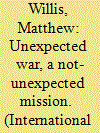

|
|
|
|
|
| Publication |
2012.
|
| Summary/Abstract |
As the fullest mobilization of Canadian men and materiel since the Korean
War, and also the costliest in blood and treasure, the 2005 deployment of the
Canadian Forces (CF) to Kandahar would deserve scholars' attention even
if it had gone according to plan. That it instead developed into something
neither the government nor the public had anticipated only enhances
the challenge-and value-of understanding it. Fuelled by the mission's
controversial nature, a sizeable literature soon developed to explain the
government's actions. The international system, institutional imperatives,
and even specific individuals have all been identified as key shapers of policy.
Diverse though it is in some respects, however, the literature is in others
strikingly homogeneous, particularly as concerns its geography: most of the
studies of Canada's third Afghan deployment have been carried out in North
America, and usually Canada.
|
|
|
|
|
|
|
|
|
|
|
|
|
|
|
|